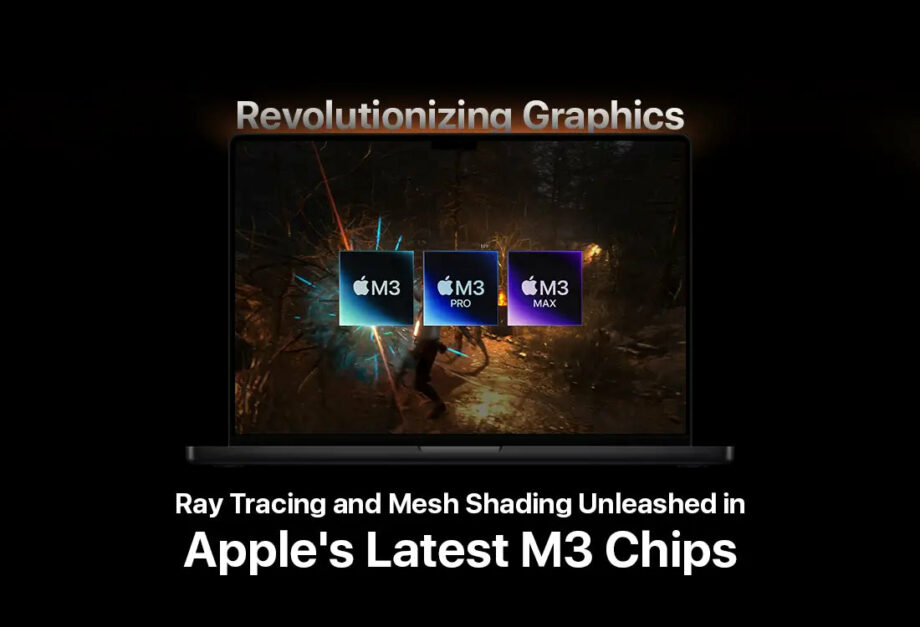Revolutionizing Graphics: Ray Tracing and Mesh Shading Unleashed in Apple’s Latest M3 Chips
In a significant leap forward for graphics technology, Apple has integrated advanced ray tracing and mesh shading capabilities into its latest M3 chips, setting new benchmarks in visual fidelity and performance for computing devices. This move not only redefines user experiences across Apple’s range of products, including Macs, iPads, and even the iPhone, but it also challenges the broader semiconductor industry to accelerate similar innovations.
Pioneering Graphics with M3 Chips
Apple’s M3 chip extends the company’s reputation for pushing the boundaries of hardware performance and energy efficiency. This chipset integrates cutting-edge technologies such as ray tracing and mesh shading, which were once the exclusive domain of high-end gaming PCs and workstations.
Ray Tracing: A Game Changer in Realism
Ray tracing technology simulates the way light interacts with objects in a virtual environment to produce highly realistic images. Unlike traditional rendering methods that use algorithms to approximate the appearance of light, ray tracing calculates the color of pixels by tracing the path that light rays take as they bounce off surfaces. This capability allows for stunning visual effects, including realistic reflections, refractions, and shadows.
Apple’s implementation of ray tracing in the M3 chips enhances the realism of graphics without the steep hardware demands traditionally associated with this technology. Through optimized silicon design and deep software integration, the M3 chips provide this advanced visual feature while maintaining power efficiency, making it viable even for mobile devices.
Mesh Shading: Elevating Complexity and Performance
Mesh shading, another flagship feature of the M3 chips, revolutionizes how complex scenes are rendered. By efficiently managing and processing geometric information, mesh shading allows for the rendering of highly detailed visual scenes at high speeds, thereby reducing the workload on the CPU and avoiding performance bottlenecks.
This technology dynamically adjusts the level of detail for different parts of a scene based on viewing conditions, which can lead to significant performance improvements in graphics-intensive applications. Whether it’s for professional design software, high-end gaming, or immersive AR and VR experiences, mesh shading on the M3 chips brings a new level of detail and smoothness to graphics rendering.
Impact on Gaming and Professional Graphics
The graphic advancements brought by Apple’s M3 chips have profound implications. For gamers, these developments mean more immersive and visually captivating experiences on more portable devices. Game developers can now deliver console-quality visuals directly on Macs or even iPads, broadening the gaming market and enhancing mobile gaming experiences.
In professional settings, graphic designers, architects, and engineers can leverage these enhanced capabilities for more detailed visualizations and real-time rendering. This improvement not only boosts productivity but also enhances creativity by allowing professionals to explore more complex and resource-intensive designs without hardware limitations.
Industry-Wide Repercussions
Apple’s integration of ray tracing and mesh shading in its M3 chips is likely to set off a ripple effect across the tech industry, pushing competitors to integrate similar technologies into their chips. This competition will accelerate advancements in graphical capabilities, potentially making high-end visual effects more accessible across a broader range of devices.
Additionally, this shift might influence software developers to optimize their applications to take full advantage of these new capabilities, leading to a new generation of apps and services designed around the potential offered by advanced graphics processing.
Conclusion
Apple’s latest M3 chips are not merely an incremental upgrade; they are a significant stride towards a future where stunning visuals can be rendered with great efficiency across all types of devices. By democratizing access to premium graphics technologies like ray tracing and mesh shading, Apple not only enhances its own product lineup but also pushes the entire tech industry toward a more visually innovative future.
